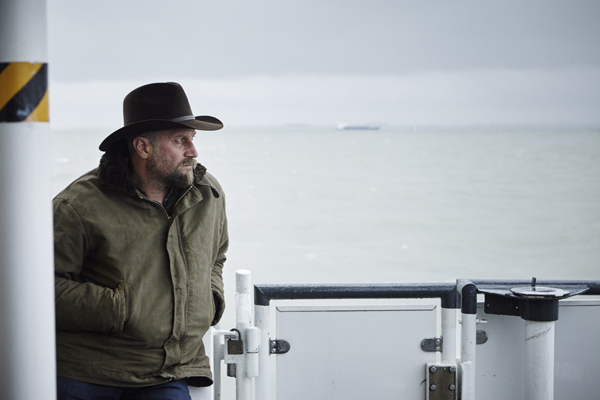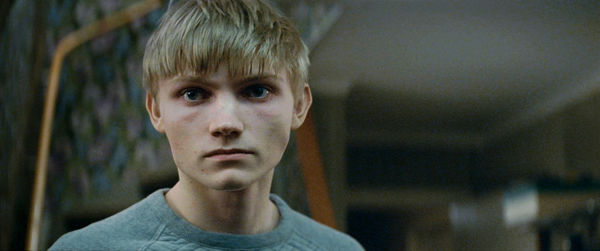John C. Reilly was a triple threat at Cannes, costarring in Lobster and sharing screen time with Salma Hayek in Tale of Tales, two films in the competition. He also popped out of nowhere in a cameo in Thomas Bidegain’s debut, the French-language Les Cowboys, one of the most ambitious films in the entire festival. (Reilly parle anglais, by the way.) To top it all off, he also performed “Just a Gigolo” with his band, the Flyboys, at the closing night ceremony, held on his birthday, May 24. With all due respect to Cannes perennials Marion Cotillard or Isabelle Huppert, one could say he was the face of Cannes this year.
Les Cowboys joined Son of Saul and The Here After as the most engrossing directorial debuts that I saw at Cannes (18 total). These three also stood out in contrast to many premieres by established directors competing for the Palme d’Or, such as Joachim Triers’s familiar family drama Louder than Bombs, funded largely with French money, directed by a Norwegian director, and starring a mostly American cast; it felt designed by committee. Chinese director Jia Zhangke returned to the festival after his hard-hitting A Touch of Sin (2013) with Mountains May Depart, which had symbolism so heavy that it nearly toppled the plot. Based on an unfinished script by François Truffaut, Valérie Donzelli’s Marguerite & Julien wallowed in tedium, with no chemistry between the on-screen lovers in a period mishmash of aristo sister-and-brother love. It left viewers neither repulsed nor strangely attracted but merely indifferent.
One thing that sets Les Cowboys apart is that it features a French working-class family as a stand-in for America. During the opening sequence, viewers may be confused about exactly where the film takes place, assuming that it’s set along the Vermont/Quebec border. Everyone speaks French at a rural lakeside fair, with country music playing in the background, couples square dancing, and the Confederate flag flying high. On the bandstand, a man in his early forties, Alain, croons “Tennessee Waltz” before stepping down and asking his red-headed 16-year-old daughter, Kelly, for a dance. That will be the last time he sees her. When it’s time for the family to depart the festivities, she’s nowhere in sight, and no one has seen her leave.
Kelly’s friends have limited information regarding her whereabouts: she had cut off ties with them and started hanging out with her boyfriend, Ahmed, all of which is news to Alain, his wife, and preadolescent son, Georges, also known as Kid. Searching his daughter’s bedroom, Mom and Dad find a notebook in Arabic. A letter from Kelly later arrives, in which she reassures her family that she’s fine but stresses that she doesn’t want them to find her.
Wearing a uniform of Levi’s and a 10-gallon hat, the gruff Alain (a steadily simmering François Damiens) quits his job and treks across Europe to bring her back home. He’s joined by Kid, now a teen, on the road, where at one point they venture to gray Antwerp, where they have heard that Kelly, now called Aafia, resides. The movie’s middle section takes place years later in Pakistan, where Reilly makes his appearance as an American private contractor settling the ransom money to free Western hostages.
The director has cast a wider net than many of the other filmmakers in the festival, making many movies seem modest and insular by comparison. With a storyline that begins in 1994 and carries over for the next two decades, Bidegain (screenwriter for Rust and Bone and Saint Laurent) sets out to convey the larger cultural changes on a global scale through a working-class family’s encounter with the Muslim world. Fifteen years of recent history has been distilled into a timely and compact message delivered with thoughtfulness and pragmatism. With the plot moving around in place and time, there is detective work for the audience as well, but no matter how elliptical the time line, the film remains coherent.
Alain’s quest to find his daughter and the film’s title will of course bring to mind John Ford’s The Searchers, which also features a cultural clash. Like John Wayne’s taciturn Civil War vet Ethan Edwards, Alain doesn’t exactly make it clear what he will do if he accomplishes his mission—keeping in mind that Ethan wants to find and kill his kidnapped niece for going native.
The title refers to an icon of Americana and to what was seen as the George W. Bush administration’s black-and-white, “You’re either with us or against us” cowboy diplomacy. It’s also not for nothing that George’s nickname is Kid, yet the movie is inspired by genre, not imitative. This Western-as-a-fable takes a simple idea and expands it to its limits; Les Cowboys stays on focus, while packing in a lot of story. Concise yet overflowing with incident, it’s intimate and large scale, told with hindsight and immediacy.
Sometimes attending a screening where one knows absolutely nothing about the director or the film is a gamble that pays off. Such was the welcome case regarding the Swedish slow-burner The Here After, not to be confused with Atom Egoyan’s The Sweet Hereafter, though the films, both beautifully acted small-town tragedies, complement each other well. (The blue-toned 35mm cinematography by Lukasz Zal [Ida] adds an extra layer to the Scandinavian frostiness.) At first, I thought it would be easy to walk out of this one to catch another film; nothing much happens at first, just vignettes of everyday life filled with awkward moments and banter. However, given a chance, the film’s quandary draws you in.
John, a lanky, blond boy of about 17 with a bowl cut, places his neatly folded clothes in his suitcase. With his taciturn father by his side, he heads on out of what looks like a clean and quiet dormitory, with a good-bye hug from a grandmotherly type. At dinner his first night home, his preadolescent brother Filipi offers the first hint of why his older brother has been away, asking John if he ever dropped the soap in the shower. Dad quickly changes the subject, telling a groaner of a bad joke.
Quiet and timid, John is often filmed from behind. Even up close, he’s not always easy to read (he could be an older Child of the Corn), but Swedish pop star Ulrik Munther’s restrained performance adds to the mystery. For the first half hour, viewers are several steps behind John’s backstory, until the rural town reacts to his arrival.
The seemingly meandering minimalist drama takes an abrupt turn when the family of three shops at the supermarket and John is violently attacked by a middle-age woman. Soon after, his return to school is greeted with raised eyebrows; the principal admits that he’s surprised that he has come back. When John enters a classroom on his first day back, a female student gets up and leaves. Bullying begins and intensifies, yet John won’t fight back, even in self-defense.
Part of what makes this so involving is that director Magnus von Horn doles out one piece of the puzzle at a time; therefore, no spoilers—only to say that a crime lies behind John’s ostracization. In many ways, the drama becomes a teen version of the lynch mob vs. the passive loner dynamic in Thomas Vinterberg’s The Hunt, although in this case, John’s guilt is not in question. You can’t go home again, indeed.
In a year when so many films at Cannes stuck to a rigidly formality without varying the pace or tone, it was a relief to see a film take twists and turns into the unexpected and to accelerate the momentum. Along with Les Cowboys, this one was also found in the Directors’ Fortnight program, which this year fulfilled its mission of introducing two rising filmmakers to the press and public.


















Leave A Comment